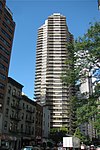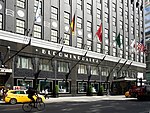Ithaka Harbors
Andrew W. Mellon FoundationBibliographic database providersEducational publishing companiesNon-profit academic publishersPages containing links to subscription-only content
Ithaka Harbors, Inc. is a US not-for-profit organization whose stated mission is to "help the academic community use digital technologies to preserve the scholarly record and to advance research and teaching in sustainable ways". It is the parent company of digital library website JSTOR, the digital preservation service Portico, and the research and consulting group Ithaka S+R. Ithaka was founded in 2003 by Kevin M. Guthrie. Ithaka's revenue was $86 million in 2014, most of it ($69 million) from JSTOR service fees.
Excerpt from the Wikipedia article Ithaka Harbors (License: CC BY-SA 3.0, Authors).Ithaka Harbors
East 61st Street, New York Manhattan
Geographical coordinates (GPS) Address Nearby Places Show on map
Geographical coordinates (GPS)
| Latitude | Longitude |
|---|---|
| N 40.763333333333 ° | E -73.966388888889 ° |
Address
East 61st Street 153
10065 New York, Manhattan
New York, United States
Open on Google Maps







